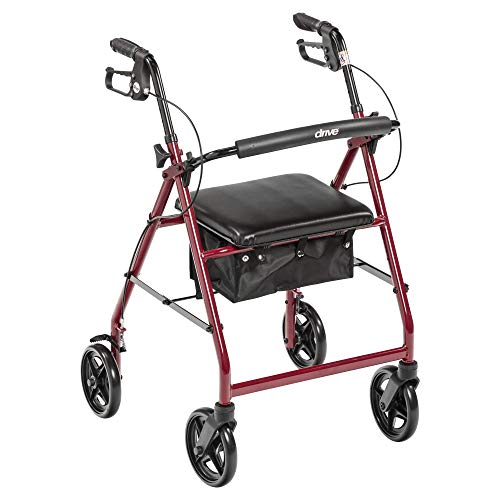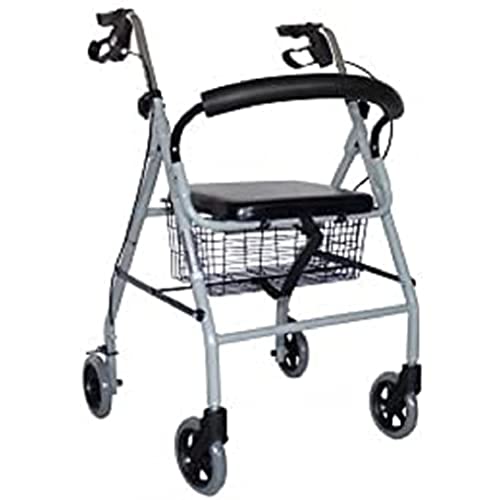The 9 Things Your Parents Teach You About Seat Walkers & Rollators
페이지 정보
작성자 Gerard 댓글 0건 조회 5회 작성일 24-09-13 05:32본문
 Walkers With Seats
Walkers With SeatsWalkers with seats permit users to maintain their normal gait while walking, reducing back pain as well as other wrist or hand injuries. They also aid in independence by allowing continuous movement.
Aluminum frames are used to make lightweight walking aids that can be adjusted and repositioned with seats. The padded seat allows the user to rest when they need to.
Folding
For those who require additional stability when walking, a folding seat walker is the best choice. These mobility aids enable users to relax at any time. This provides safety and comfort on longer trips or outings. They are easy to maneuver and come with built-in storage options such as bags or baskets beneath the seat that folds up. You can also purchase an array of accessories to go with your model, such as storage bags and trays.
Handle grips on a folding seat rollator or walker are typically constructed from foam, plastic or gel. If the grips do not feel comfortable, users can swap them out with ones that are more suitable for their hand size. If your hands sweat a lot, or you suffer from arthritis or any other gripping issue and grips that are larger may be the best choice.
Three-wheeled walkers offer less stability than four-wheel models but are easier to control and maneuver in tight spaces. They are also smaller and lighter, making them ideal for storage or transport in small apartments and homes. Certain models with three wheels even have a collapsible seat walkers & rollators, that can be folded when not in use to conserve space.
The EZ Fold N Go Rollator comes with all the benefits of a traditional walker, but it folds 3 times smaller than other rollators. It can be transported easily in a car or bus. It is the perfect option for those who need an walker with a seat but have a limited space and frequently need to transport. It is lightweight rollator with seat and includes a storage bag, a front pouch, and back strap.
Four-Wheel
Four-wheel walkers with seating are a great choice for those who want to take long walks outdoors or needs more support than a simple rollator. These walkers are also ideal for those who suffer from back and hip pain, as they maintain posture and take the burden off their knees. Many come with storage bags or baskets to store personal items. Some are equipped with padded seats for added comfort, particularly on long journeys. Some come with adjustable handles to give users the ability to customize their seat. Others even feature a lower spine support backrest.
Choose models with larger wheels (8" or more in diameter) that can handle uneven surfaces like gravel. Some models have an adjustable lever known as"curb climber" that allows the "curb climber" to lift the front wheels above obstructions like curbs. For indoor use, a smaller set of wheels can be better to maneuver through narrow hallways and doorways.
Handle grips should be comfortable and easy-to-use especially for people who have arthritis or sore hands. Some come with soft or gel grips, which are good for people with arthritis. The handle's height should be adjustable to allow an individual fit. Some models come with a brake mechanism that locks into place when brakes are applied. This can be useful for those who have a tendency to activate the brakes as they move around.
If you're looking for a walker with a seat, look for one that includes one or has an accessory holder that can be used to add seating. A padded seat will make users feel more comfortable during breaks. Some walker-seat combinations have a backrest to support the spine and keep posture straight.
Push-Down Brakes
You can activate the brakes operated by hand on walkers and rollators by pressing down the brake levers. These levers could look like loops or bicycle-style brakes built into the handles.
You can lock them in the same way as you would brakes on a bicycle, but by pressing harder. This will give you more stability when you need to sit still or rest on the seat.
Certain manufacturers offer a brake that is activated by pushing down the pedal. This makes it more convenient for those who are petite or have arthritis or other gripping issues. These brakes are also a great option for those who live in areas with hills, where the increased downward pressure on the wheels can make stopping or slowing down the walker a challenge.
All walker brakes require regular tightening, which allows them to keep their effectiveness and reduce the chance of causing damage. It's easy to accomplish, and usually involves finding the adjustment screw for the cable that is located near the brakes. Using the correct tool (which differs from model to model) you'll turn it clockwise until it's secure enough for safe and consistent operation.
Certain models listed here include locking brakes that you activate by pressing down on the brake levers using one or both hands. They're ideal for people who need to stay upright but want to stop and relax on their seats. The brakes let you navigate tight spaces, make sharp turns, and keep the walker on uneven or rough terrain. It is essential to know how to spot the indicators that your walker's brakes need adjustment, such as rolling unexpectedly or not stopping in a timely manner when the brakes are engaged.
Slow-Down Brakes
A slow-down brake is a distinctive feature of a rollator that lets the user limit the speed of a wheel, so that it won't suddenly accelerate to a fast speed and then begin to move away from the walker. This improves security, particularly if the user is walking down a slope or over rough terrain. It's also a useful feature for users with one side of their body that is more powerful than the other, as it balances the direction of the user's path of travel.
 These systems of braking are generally easy to use, even for users with limited hand strength. They rely on a simple push/pull lever to engage and deengage. Some brakes with slow-down capabilities allow you to alter the resistance level. This allows the walker to be used in a range of terrains and conditions.
These systems of braking are generally easy to use, even for users with limited hand strength. They rely on a simple push/pull lever to engage and deengage. Some brakes with slow-down capabilities allow you to alter the resistance level. This allows the walker to be used in a range of terrains and conditions.You should consider a walker with a seat if you want to be hands-free. This will give you a place to rest when you're on longer trips, and also give the walker more stability. Some models of walker include an e-table that can be used to store things like food or medication.
A hybrid rolling walker is another type of walker for people who are able to maintain their balance but require assistance in achieving their endurance and stability. This mobility aid features design elements that are common to both traditional walkers and rollators, including the ability to fold down compactly with a seat, as well as adjustable height handlebar. Certain hybrid rolling walkers are designed to be heavy-duty to be able to support greater loads. You can find a wide range of hybrid walking walkers on our website. Some hybrid rolling walkers come with a variety of accessories like tray attachments or baskets that will help you carry your items.
Seat
Walkers with seats are great for individuals who need a little extra stability support when they go for longer walks or just need a place to rest while walking. They can be beneficial for those suffering from diminished weight bearing, neurological conditions like Parkinson's disease and stroke or general dizziness. Walkers with seats are usually able to be fitted with handy accessories such as baskets for storage, baskets and bags for carrying belongings and oxygen tank holders and a forward-facing light that can aid users in dark areas.
Rollators are designed to be easy to move indoors and outdoors with swivel wheels that allow them to turn quickly. They are typically lightweight and adjustable for height, so they can be used by people of all sizes comfortably. They can also be fitted with useful accessories, such as baskets and bags for carrying belongings. They can also be equipped with oxygen tank holders, I.V. poles, and more. They also have hand brakes that allow users to stop or slow their rollator easily, which helps prevent it from rolling away and potentially harming them.
There are three-wheel models as well which are smaller, lighter and can be squeezed into smaller spaces. They are more maneuverable however they don't offer as much stability. They may not be suitable for those who have to lean heavily on the device to support themselves. all terrain rollator with seat rollators are equipped with hand brakes, which allow them to be slowed down or stopped at any moment by squeezing their handles. They can also be set to "park" brake, which keeps the brakes in place for a long time. Certain models come with grips that can be replaced with soft ones for greater comfort, specifically those that are used by people with hands that tend to sweat.
댓글목록
등록된 댓글이 없습니다.

